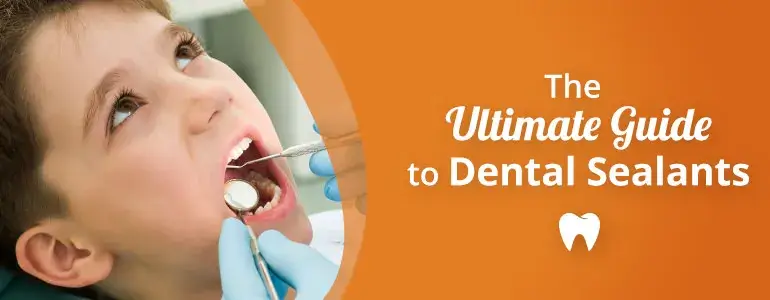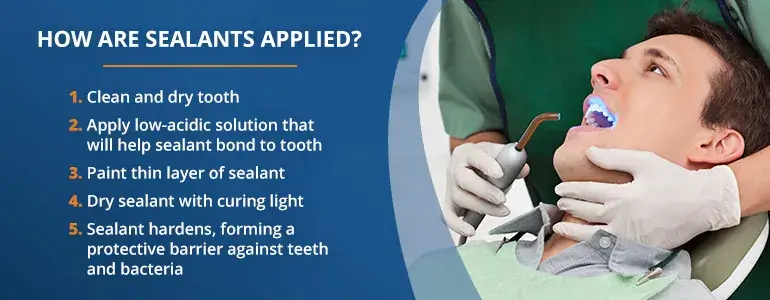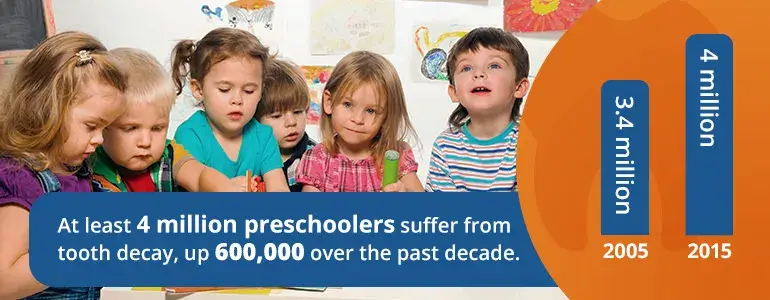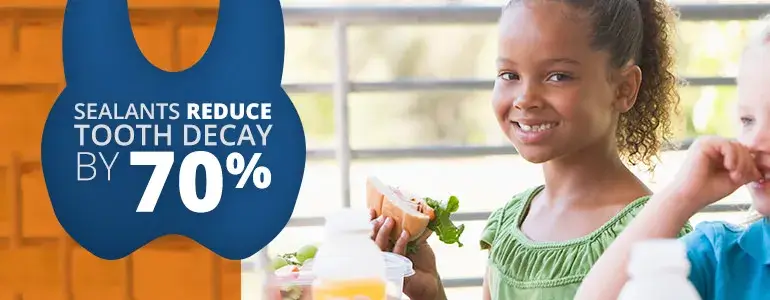
Dental sealants are one of the most important inventions of modern dentistry. The first tooth sealants were produced in the late 1960s and early 1970s. Since then, sealants for kids have become a major weapon to prevent tooth decay. There has been a national effort to get all kids’ teeth sealed, including low-income children whose dental hygiene is too often neglected. However, there remain misconceptions and confusion about dental sealants. Among the biggest questions:
- Are dental sealants safe?
- How long do dental sealants last?
- Can dental sealants be removed?
- Do dental sealants for children really reduce risk of cavities?
At our Phoenix, AZ-area dental offices, we hear questions like these from patients every day. We’ve assembled answers that should help you gain a better understanding of dental sealants and why you should consider them. We’ll even discuss dental sealants for adults – yes, they do exist. Read on for an in-depth look at dental sealants pros and cons, including why more kids than ever are having them put on.
What Are Dental Sealants?
Think of dental sealants as an umbrella. They shade teeth from all the stuff that can rain down on them, from sugar to bacteria to bits of food that get trapped in the teeth. A dental sealant is a thin coating applied to premolars and molars. This smooth seal is applied over the deep grooves in the chewing surface of the teeth. The sealant is made of plastic or resin-based material. It’s either white or clear, so no one can tell you have sealant on your teeth. In fact, the sealants are so thin you won’t feel a difference in your mouth, either.
How Are Sealants Applied?

Dental Sealants for Children
The majority of dental sealants are applied to kids’ teeth. There are three main reasons for this:
- Fissures and pits are more likely to develop on children’s molars and premolars
- Kids’ tooth-brushing skills are not as strong as adults’, so they need extra protection against cavities
- They work best when they are applied to a tooth’s surface as soon as it comes in
Dentists generally recommend sealants be applied to teeth from ages 4 to 15. These are the years when kids are most likely to get cavities. However, in rare cases, they may recommend tooth sealants for baby teeth if a child is prone to cavities.
Dental Sealants and Dental Hygiene
It’s important to remember that while sealants do offer protection from cavities, they are not substitutes for brushing or flossing. Children with dental sealants should continue with their regular dental hygiene routine of brushing at least twice a day and flossing daily. They should also continue to take in fluoride through municipal drinking water or fluoride treatments we can provide in our offices. Parents sometimes slack on fluoride because they assume kids’ teeth are being protected by sealants. While they do provide protection, fluoride strengthens teeth and helps ward off cavities, too, so it’s best to use both measures together.
Should Kids Get Dental Sealants?
We recommend sealants for most kids as they can have tremendous cavity-fighting benefits. Many experts across the country agree and say sealants even could help with social problems as well. Among low-income children, dental care is lacking. There has been a big push in recent years by governments at the federal, state and local levels to get more kids tooth sealants, in order to ward off tooth decay. Studies have found kids with dental problems are more likely to have oral health problems when they become adults , and this can lead to serious issues such as having trouble holding down a job. A staggering low percentage of low-income kids, just 20 percent, have tooth sealants. This percentage is higher among kids from higher-income families, at 40 percent, but that’s still not even half of the children in the United States. The American Dental Association and other groups are pushing to get those numbers up.
Dental Sealants for Adults
Kids are not the only ones who can benefit from dental sealants. Adults can also get dental sealants, although they do so in much smaller numbers. There are three main reasons for this:
- Adults brush their teeth more efficiently and with more care than kids, so there’s less need to protect them from cavities.
- Many people think sealants are only for kids and never even think of getting them as adults.
- A lot of insurance companies will cover tooth sealants for kids but not for adults. This makes it much less likely that adults will get the protective coverings, becauue they have to pay out of their own pocket.
We may recommend sealants for adults who have a high propensity for cavities. For instance, if you have three molars with significant decay, we may recommend a sealant on the fourth molar to protect against future cavities.
How Long Do Dental Sealants Last?
Dental sealants take just a few minutes to put on, but they can last for up to 10 years, and slightly more in some cases. During your regular dental checkup, we will check your sealants for chips or wear. For example, if you suffer from bruxism, or grinding of the teeth, your sealants may wear down quicker than 10 years. Sealants may need to be replaced if they suffer significant chips. Repairs don’t take long, but many people simply outgrow their sealants. They may get them as kids but let them lapse after becoming adults.
Dental Sealants and Cavity Prevention
Many patients at our Phoenix-area practice want to know if sealants can prevent tooth decay. When they consider getting sealants for their kids, they want assurance this procedure will help with cavity prevention. Tooth decay is a serious problem among children because of the way their teeth grow. When they get their first molars, they develop pits and fissures on these teeth. It’s very difficult for toothbrushes to reach these deep crevices. Bacteria may grow inside them because they cannot be sufficiently cleaned. Other things also contribute to a high incidence of tooth decay among children, including:
- Frequent snacking on sugary food or drinks
- Poor job brushing as the child takes over this duty from a parent
- Drinking bottle water, which does not have fluoride to protect against tooth decay
Sealants are an excellent way to prevent cavities. The American Dental Association says adding a sealant to a tooth can reduce the occurrence of cavities by 86 percent in the first year. Over a four-year period, the risk of cavities declines by 58 percent. Over a full decade, says the ADA, the success rate grows to up to 90 percent. That’s a powerful argument for getting sealants, and yet only 40 percent of U.S. dentists with children in their care apply sealants.
How Much Do Dental Sealants Cost?
Dental sealants’ cost will vary depending on your dentist and what area you live in. The teeth sealants we use in Peoria, AZ, for example, may be cheaper than in a place with a higher cost of living, such as Los Angeles. Generally, dentists charge a certain price per tooth. Often insurance will cover this cost, but you should check beforehand. Something to keep in mind: Sealants are less expensive than fillings. Since teeth sealants are designed with cavity prevention in mind, it may be cheaper in the long run to get your child sealants rather than risk fillings down the line.
Dental Sealants Safety
Remember what we said earlier about only 40 percent of U.S. dentists applying sealants to kids at their practices, despite ADA recommendations that they do otherwise? Well, there’s a reason for that. Dental sealants have been in use for decades, yet not all dentists are convinced they are in the best interest of their patients. One area of controversy: What happens to cavities or pre-cavities that are covered over with sealant? The ADA says nothing will happen. Studies have determined cavities or decay covered by sealants simply stop growing, because the area has been closed off from further bacteria. The ADA says this will not cause further harm to a tooth. Yet some dentists aren’t convinced this is the case. While no one has proven otherwise, these dentists do not use sealants because they worry cavities will continue growing beneath a sealant. There is another area of sealant safety that dentists may be concerned about as well.
What About BPA in Teeth Sealants?
You may have heard references to the presence of bisphenol-A (BPA) in dental sealants. BPA is a chemical that has been used since the 1960s to make polycarbonate plastic and epoxy resin. In 2008, headlines began screaming about the risks of BPA. Up until then, it had been used in dozens of products, from baby bottles to fast-food containers to dental sealants. The risks from BPA are still not entirely clear. However, a few studies have shown exposure to BPA among animals can impact:
- The brain
- Behavior
- Prostate glands in fetuses
- Hormone levels
- Heart health
Up until 2010, the Food and Drug Administration claimed BPA was safe. Then the department changed its stance, noting concern about the long-term effects of the plastic.
BPA’s Long-Term Impact Remains Cloudy
Still, BPA continues to be used in many products. There have not been any studies of humans that prove it is dangerous and nothing conclusive showing that BPA caused the health problems it has been linked to. BPA is used in a small number of dental sealants. Another chemical, bis-GMA, is used more often in the manufacture of resin-based sealants. A recent study in Pediatrics found that in 90 percent of the U.S. market share of dental sealants, BPA is not one of the starting ingredients. Further, the only evidence of BPA exposure among dental sealant users has been in saliva, where exposure measures very low. The bottom line on BPA in dental sealants: It’s not a big risk. The amount of BPA is trace, if anything, and the jury is still out on whether this chemical constitutes a real concern. If you are worried about BPA and sealants, we are always happy to answer your questions at our greater Phoenix, AZ area offices. Rest assured, we would not do the procedure if we thought there was any long-term risk.
Dental Sealants Pros and Cons
You may still be wondering whether dental sealants are right for you or your child. Here’s a rundown on some pros and cons of dental sealants that can help you make your decision.
- PRO: They cut down on cavities. Research has shown kids with sealants get fewer cavities. If your child has trouble brushing on their own or if they have shown a propensity for cavities, sealants may be a good solution.
- CON: Insurance won’t pay for adults. Many insurance companies refuse to cover sealants for adults. Some justify it by saying adults’ teeth become smoother with age, eliminating the fissures and pits sealants are designed to cover for kids. If you want to avoid out-of-pocket expenses, you may decide to skip sealants as an adult.
- PRO: Recommended by the ADA. The American Dental Association recommends all kids receive sealants in order to protect their teeth as they age.
- CON: Lack of long-term BPA research. Some people are worried about the risks of BPA. While dental sealants have not been proven to have any serious health concerns, if you are wary of BPA, you may decide sealants are not for you or your family.
- PRO: Save money in the long term. Sealants can reduce or eliminate the need for fillings and other dental work, saving you money over time.
- CON: Lack of permanency. Dental sealants can be removed over time. They are not permanent and you may need to have them replaced if you develop chips.
- PRO: Protect vulnerable parts of the teeth. Even the best of brushers may miss the fissures and pits sealants are designed to protect. That can lead to a germier mouth. Sealants make for a cleaner, healthier mouth.
Get More Information About Dental Sealants
There are many benefits to dental sealants, no matter what your age. To find out more, contact AZ Family Dental today. We can answer your questions about tooth sealants and whether they are right for you or your child.


